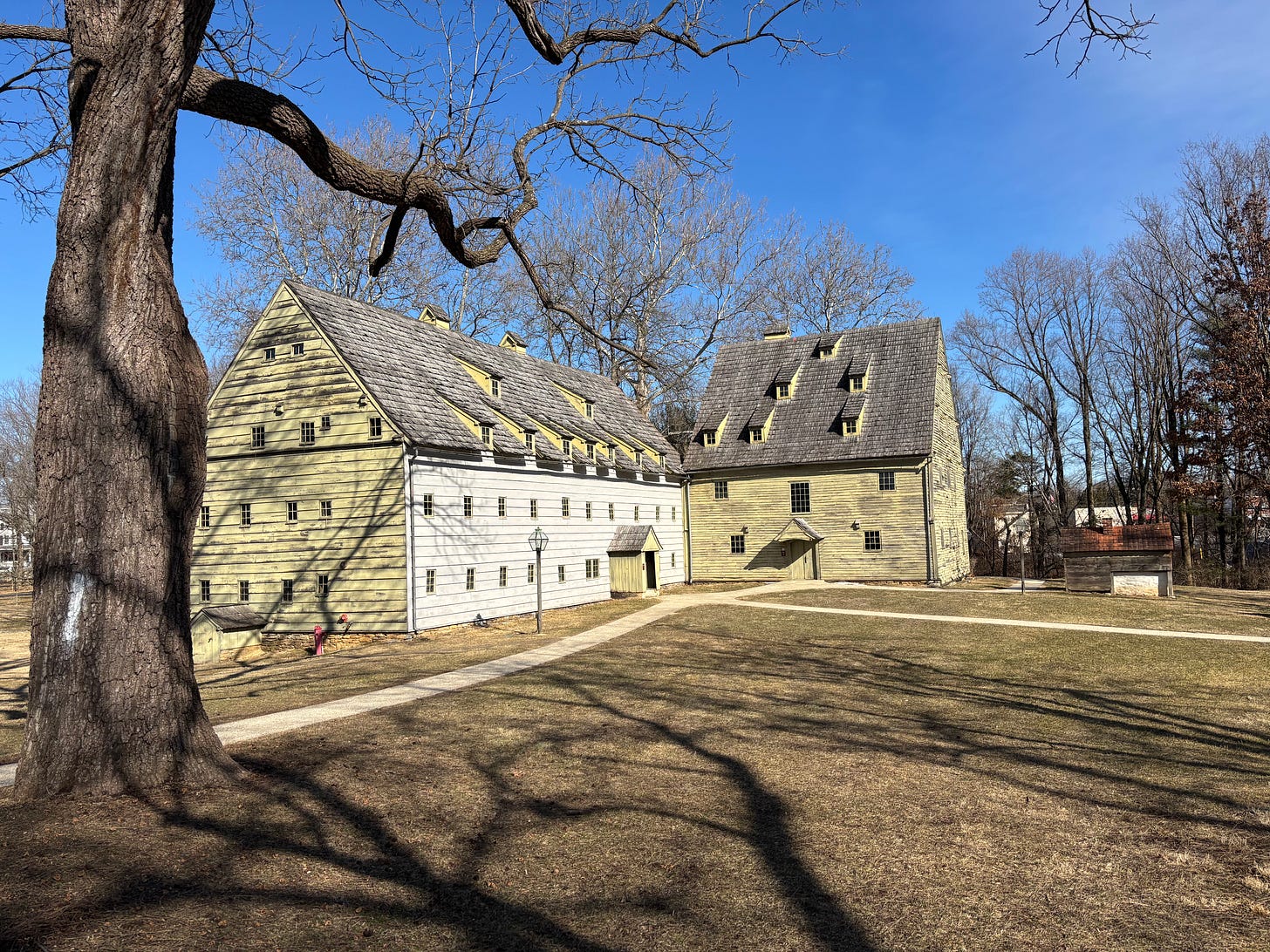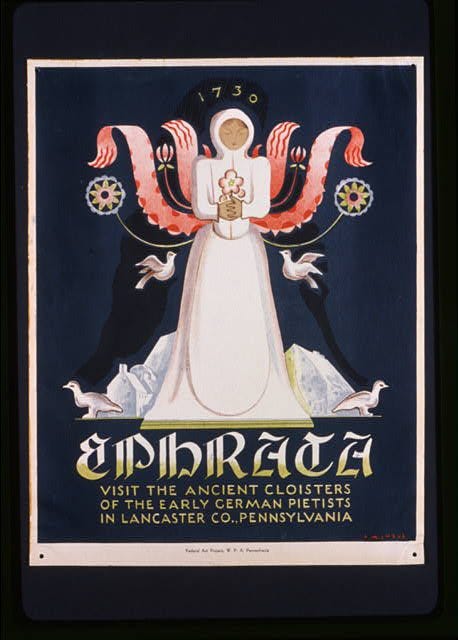An Excursion to Ephrata
Rosicrucians in America, Communalism and the Hermetic Origins of Mormonism
Back in mid-February I took an excursion from New York City out to Ephrata, Pennsylvania. It’s a small town—or a borough, as they call it out there—with a population of some thirteen thousand. Tucked in a northeastern corner of Lancaster County, Ephrata’s name derives from Ephrath, an early name for Bethlehem given in the Book of Genesis, chapter 35, verses 16 through 19.
16 Then they journeyed from Bethel, and when they were still some distance from Ephrath, Rachel was in childbirth, and she had hard labor. 17 When she was in her hard labor, the midwife said to her, “Do not be afraid, for now you have another son.” 18 As her soul was departing, for she was dying, she named him Ben-oni, but his father called him Benjamin.19 And Rachel died, and she was buried on the way to Ephrath, that is, Bethlehem.
Ephrath, or Bethlehem, was central to the contours of millenia-old Messianic prophecy: it’s in the Book of Micah where Bethlehem is identified as the eventual birthplace of the Messiah. The reason for giving the name ‘Ephrata’ to this little town in rural Pennsylvania was born from a similar sense of divine providence. It was the home of a religious community—a cloister—that was formed in 1732 and was intended to serve as a model for a civilization built upon perfection. The community didn’t last, but we did get some beautiful Works Progress Administration posters commemorating its existence:
My interest in the Ephrata Cloister comes from a deep fascination with a little-known sect that arrived in Pennsylvania in the late 1680s: the Society of the Woman in the Wilderness. Led by a Christian occultist named Johannes Kelpius, the Society erected a monastic community on the banks of the Wissahickon Creek and awaited the ending of the world, which they believed would occur in 1694.
Under Kelpius’ leadership, the Society of the Woman in the Wilderness dabbled in all forms of esoteric. They practiced alchemy—there’s a story that Kelpius possessed the fabled Philosopher’s Stone, which he tossed into the streaming waters of the Wissahickon shortly before his death—and they built a large tabernacle upon which sat a telescope that allowed them to track and study the movements of the stars, planets, constellations. The titular ‘woman’ in the Society’s name (and it must be stated that this was not their self-appointed name, but one bestowed upon them by locals and scholars) is the one referenced in the Book of Revelations, Chapter 12, Verse 6:
And the woman fled into the wilderness, where she has a place prepared by God in which she is to be nourished for 1,260 days.
Kelpius’ Society was strongly influenced by Joachim of Fiore, a Christian theologian, mystic and apocalyptic thinker who died in the year 1202 A.D. Key to Joachim’s apocalyptic ruminations was a tripartite model of sacred history, the division of historical time into three epochs: the Age of the Father, the time of the Biblical Old Testament; the Age of the Son, running from the birth of Christ to the year 1260, and the Age of the Holy Spirit. The latter was envisioned as an eschatological utopia—the hierachy of the Catholic Church would be dissolved and replaced with the ‘Order of the Just’. Society would achieve a state of perfection, the knowledge of God’s word in its innermost, hermetic sense would be apprehended by every individual, and a “reign of freedom” would be inaugurated.
Out there isolated on the high, wooded frontiers of Pennsylvania, the Society maintained the core of Joachim’s triadic model of history, but granted each stage a new name. The Age of the Father became that of the Barren Wilderness, the Age of the Son the Fruitful Wilderness, and that final stage, the Age of the Holy Spirit, was transmuted into the Wilderness of the Elect of God.
(Side note: the Society were not the only ones influenced by Joachim of Fiore. Deleuzeheads might recognize his name from Difference and Repetition. There, Deleuze offers three forms of repetition, through which he articulates his three ‘syntheses of time’. In a very compelling series of passages he finds the three forms of repetition in Marx (history as farce, history as tragedy, history as the production of the New), in Holderlin’s analysis of the Oedipus myth (before the tragic event, the event itself—the caesura, the cut—and what follows after the event), in the three ages of Vico (the Age of Gods, the Age of Heroes, and the Age of Men), and, finally, in the three ages of Joachim of Fiore.
For Deleuze, all three are the same in an abstract sense. The first two stages in Marx, Holderlin/Oedipus, Vico and Joachim are all about forms of repetition that allow the cyclical formations to take take place. But the third, for Deleuze, is the Nietzschean Eternal Return in the most hermetic sense of the doctrine: the Eternal Return not as the infinite return of the same, but the return of Difference-in-itself. This is the explosion of the cycles by the straight line of time itself, the ripping-open of all things to the future. Once the third stage is achieved, Deleuze writes, there is no going back: the Eternal Return “renders impossible the return of the other two. Only the third Testament turns on itself.”)
There’s a pseudo-history of the Society of the Woman in the Wilderness’ origins provided by a weird little tract I purchased at the Ephrata Cloister gift shop—Coming to America: A Brief History of Johannes Kelpius and His Wissahickon Colony of Mystics (The Rosicrucian Connection). The author is Dorothy Pinkett, and she signs her name with the initials OMCE/CRC. The CRC is the Confraternity of the Rose Cross, a neo-Rosicrucian order that splintered from the Ancient Mystical Order of the Rosy Cross (AMORC), which despite its name was founded in California in 1915 by one of those classic American mystics by the name of Harvey Spencer Lewis. I don’t really know the nitty-gritty details of the AMORC-CRC split, but the latter is headquartered in Pennsylvania, which makes sense given their pre-occupations. Pinkett’s little booklet claims insider knowledge of Rosicrucianism along with access to special archival collections not readily-accessible to the non-initiated and the general public alike.
Keep reading with a 7-day free trial
Subscribe to Reciprocal Contradiction 2.0 to keep reading this post and get 7 days of free access to the full post archives.






